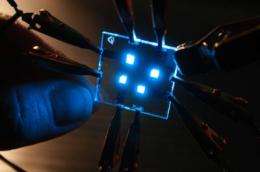Blue light specials: New materials boost efficiency of blue OLEDs by 25 percent

Lighting consumes one-fifth of the electricity generated in the United States. Solid-state lighting offers tremendous potential to improve the situation - once major research challenges are overcome.
The most promising technology is the organic light-emitting diode, or OLED. These multi-layered devices produce light by running an electrical current through a specially engineered host material into which light-producing phosphorescent molecules are embedded or "doped." The white light envisioned for large-scale applications, such as rooms and buildings, consists of red, green and blue light.
"The weakest link in OLED research is the absence of an efficient, long-lasting blue light to accompany the red and green," said Pacific Northwest National Laboratory scientist Asanga Padmaperuma. Development of better host materials to manage the flow of electricity through the device could help solve that problem.
Padmaperuma and his collegues have designed, synthesized and tested new materials that improve the power efficiency of blue OLEDs by at least 25 percent.
On Sunday, March 22, PNNL scientists will discuss advancements in blue OLED research in two presentations and a poster session at the spring meeting of the American Chemical Society.
More information:
9:00 AM-11:40 AM, Room 155 D, Salt Place Convention Center
Novel ambipolar host and hole blocking material system for blue electrophosphorescent OLEDs
PNNL scientist Asanga Padmaperuma will present design strategies developed through computational and experimental chemistry for engineering blue OLED materials.
2:00 PM-5:00 PM, Room 155 , Salt Place Convention Center
Synthesis and application of anchored 2,3,5-trifluoro-7,7,8,8-tetracyanoquinodimethane (F3TCNQ) as organic molecular dopants in OLEDs
PNNL scientist Phillip Koech will discuss a novel approach for controlling the doping concentration and molecular diffusion of the dopant material.
8:00 PM-10:00 PM, Hall 5, Salt Place Convention Center
Design of multifunctional phosphorescent emitters with charge transport moieties
PNNL scientist Asanga Padmaperuma will present a poster highlighting the team's use of computational chemistry to develop multifunctional emitter materials for blue OLEDs.
Source: Pacific Northwest National Laboratory














